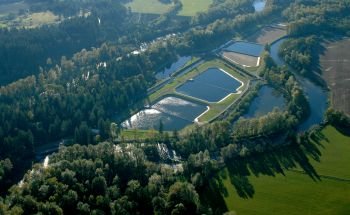Is Salem's Water Supply Safe

(SALEM, Ore) — High levels of algae toxin detected at the Detroit Reservoir prompted the Oregon Health Authority on May 15 to issue a warning to avoid its waters. The warning was lifted the following week, but the incident served as a reminder that the North Santiam River and its tributaries can sometimes hold blue-green algae toxins.
Fortunately for Salem, the North Santiam River, the source of the city's drinking water, wasn't tainted during the May incident.
What if Salem isn't so lucky during the next algae bloom? Regular tests of river water track potential algae toxin problems. The city also has alternative procedures to process water, and if necessary, backup water supplies.
Last summer, the city's emergency plans were given a practical test after algae toxin was detected at barely measurable levels near the intake of its Geren Island water treatment plant. The standard practice of pulling water directly from the river couldn't be used for several weeks.
"We're going to shut down that intake if we have any inkling we might have a concern," said Francis Kessler, operations division manager for the city's public works department.
Salem kept the taps flowing to homes and businesses in summer 2014 by drawing algae-free, groundwater from beneath Geren Island. Additional processing through a "roughing filter" and finally a fine sand filter helped ensure that the water was safe.
The result: No trace of the toxin, called cylindrospermopsin, was found in the city's finished drinking water.
Contact with algae toxin is dangerous to people and pets, and it cannot be removed by boiling or with camping-style filters.
Because of its water treatment method, Salem needs to be especially vigilant about testing its raw water source. The city relies on a sand filtration method to purify water. Chlorine is added to destroy pathogens, but otherwise few chemicals are used to make tap water
At least once a week, public works officials test water drawn from the Detroit Reservoir and North Santiam River to monitor algae levels.
"We measure down to less than one part per billion," Kessler said.
Water samples are shipped overnight to Florida to one of the few commercial labs capable of performing precise tests for algae toxins. The city spends about $85,000 a year on tests for the cylindrospermopsin. Another $40,000 a year is spent on laboratory tests for other contaminants.
While the city's public works department prevailed in its first brush with an algae toxin scare in 2014, a longer-term problem could be more complicated to resolve. City officials have contemplated the worst case scenarios.
Even if the city had to temporarily stop processing river water at Geren Island because of a contaminant, it could fall back on stored water supplies for a protracted period, Kessler said
The city has about 725 million gallons of stored water at the ready. That includes about 600 million gallons placed underground in basalt formations at the city's "Aquifer Storage and Recovery System" beneath Woodmansee Park.
City reservoirs could supply at least 125 million gallons or so in an emergency. In addition, the city has groundwater wells in east Salem.
To put things into perspective, Salem consumes about 35 million to 40 million gallons of water per day during a hot spell. Winter water demand drops to about 20 million gallons per day.
If Geren Island's capacity to produce potable water was temporarily reduced, Salem residents would certainly notice that something was wrong. Mandatory reductions in water use would be needed.
Salem Public Works Director Peter Fernandez said the city has prepared a water curtailment plan to deal with shortages. An agreement with the city of Keizer also allows Salem to access to Keizer's water, which comes from underground wells, in an emergency, he said.
The importance of preparing for water shortages was made clear in August 2014 when the residents of Toledo, Ohio were ordered to stop using the city's tap water. Algae toxin in the water supply meant no water for drinking, cooking or showering for about week.
The problem in Ohio was blamed on an algae bloom in Lake Erie, Toledo's primary water source. National Guard troops had to deliver water to Toledo residents before the crisis ended.
"We are fortunate that we have multiple water sources," Fernandez said. "The difference between us and Toledo is we have survival water."
This summer, the best Salem can do is to continue to monitor the North Santiam River. Predicting whether blue-green algae toxins will be high or nonexistent is difficult.
Low-water levels behind the Detroit Reservoir might concentrate algae growth, but the conditions that produce algae toxins aren't well understood. A large amount of algae may be harmless, while a comparatively small bloom might produce a hot spot of toxin.
Source City of Salem



